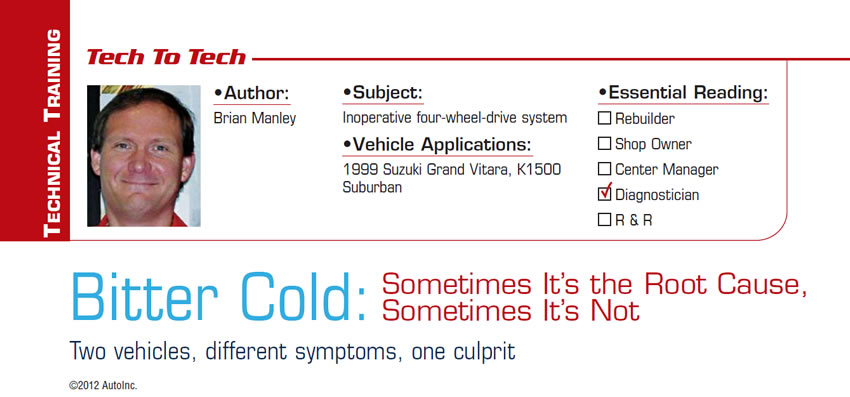
Tech to Tech
- Subject: Inoperative four-wheel-drive system
- Vehicle Applications: 1999 Suzuki Grand Vitara, K1500 Suburban
- Essential Reading: Diagnostician
- Author: Brian Manley
Two vehicles, different symptoms, one culprit
Yup, it is 0° outside (Figure 1). The good news is that it will warm up to 10°F tomorrow!
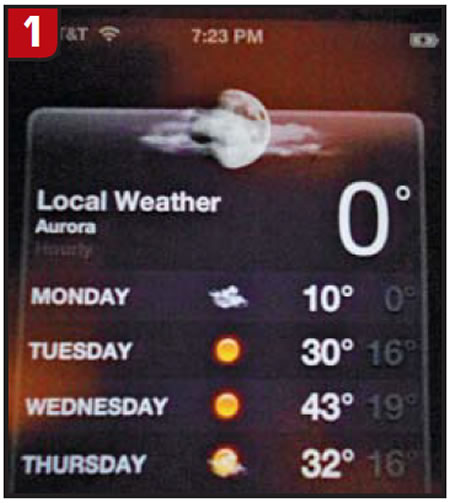
Before you think to yourself, “It never gets that cold around here,” read on. For those of you who live in fairer climates, I’ll bet you get a run on air-conditioning work the first 90°F day of the season.
Here in Denver, when the snow flies and the mercury plummets, we all like to press “4WD” on our dashboards and blast out into the blizzard. When our rigs stay in “2WD” and slide into the gutter – that’s when I get the phone calls. The following two customers called me the same morning recently, and we came to two very different conclusions after diagnosing their inoperative four-wheel-drive (4WD) systems.
A woman rolled up in her 1999 Suzuki Grand Vitara and said, “The 4WD light flashes on the dashboard, but it won’t stay in 4WD, and I’m sliding all over!”
How would you approach the customer’s dilemma? My first job was to confirm her claim, and we found that the 4WD lamp on the dash would flash on and off for about 10 seconds and then go off with a corresponding disengagement of the 4WD system. It simply was not staying in 4 high, or 4 low for that matter.
While searching through the list of hotline archives on Identifix (Figure 2), I discovered that virtually every part had – at one time – been at the heart of this 4WD system failing on Suzuki models across the country.
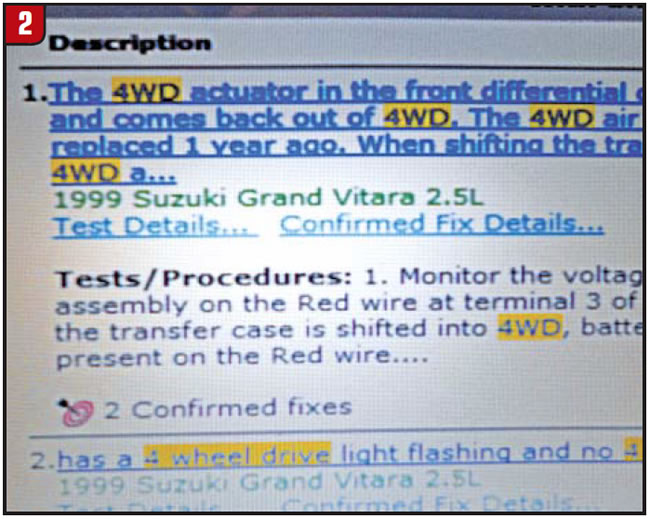
Systematically moving through our diagnosis, we discovered that the pressure pump responsible for responding to the 4WD input signal, and then creating pressure to move the actuator in the front differential, turned off at the same time as the flashing 4WD lamp on the dash.
The pump (Figure 3) was pumping, but the actuator did not stay engaged, and it seemed that the signal to the pump was being lost, so we went right to the 4WD control module (Figure 4) to test for the 4WD-switch input and the pressure-pump output. Both were present; however, everything went back into a 2WD mode after about 10 seconds – every time we engaged the system.
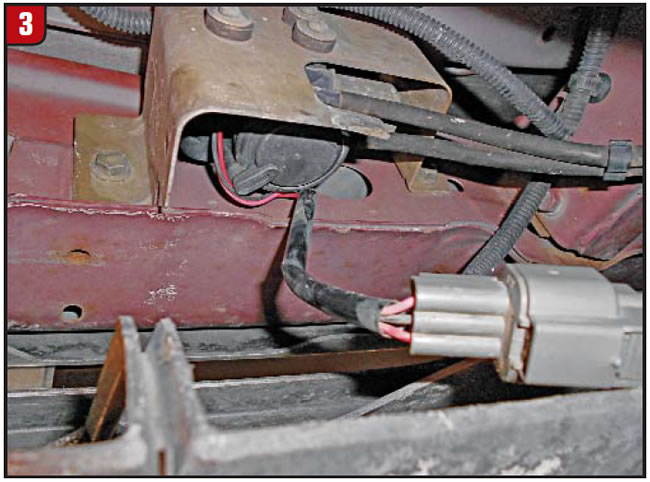

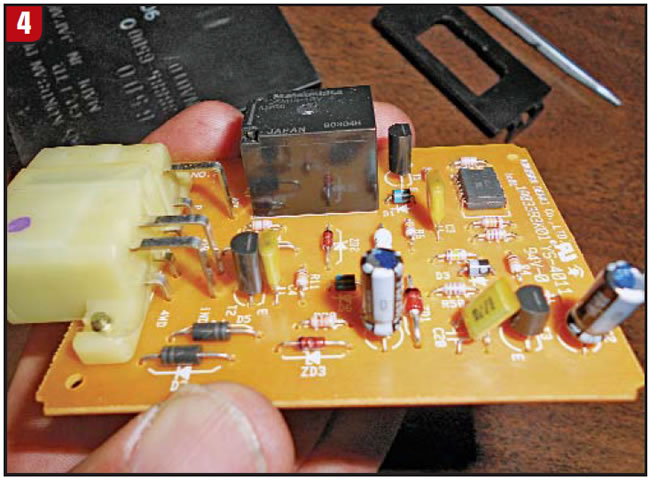
Since no flow chart existed for this system, we had to study the schematic to determine exactly why the lamp – and the actuator in the differential – would turn off at the same time. It turns out there is a pressure switch that is integrated into the pressure pump itself, and if the pressure drops, the 4WD lamp turns off and the system goes into 2WD.
I had initially checked to see if the pump was capable of creating pressure – which it was – but I didn’t check to see if it was holding pressure – which it wasn’t. To test this, we “teed” a vacuum/pressure gauge into the line at the differential (Figure 5) to determine which component was at fault. Once we did this, we found that the actuator in the differential was leaking pressure, it needed to be replaced and it needed to come from the dealer.
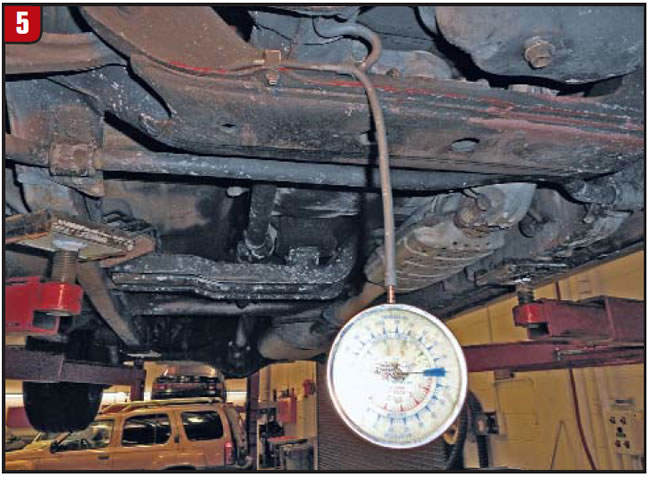
This was a unique system with a definite mechanical-part failure, but can a customer with the same symptom have their vehicle repaired without the use of any mechanical parts?

Another customer with a K1500 Suburban pulled up to my door and gave me the same concern as the other customer had earlier: “It won’t go into 4WD, and I need it today!”
After confirming that it would not engage into 4WD, I decided to search for similar concerns on Identifix. With 1,004 TSBs, and a search of “4WD engagement” issues, I found many bulletins regarding inoperative 4WD systems, and there seemed to be no pattern case failure for this model; many different root causes existed for this system’s failure. I grabbed a procedure for this truck and began to diagnose the truck. After starting to run the system through its paces, we began to notice that the front differential would engage more and more quickly, after being in our shop for an hour or more. Then after a while, the system functioned as intended, leading me to conclude that temperature had a hand in this failure. I began to wade through all of the bulletins, and I discovered one that made the most sense.
I found the ultimate answer in a General Motors TSB 66-77-04 that listed the customer concern as: “Some owners may report that if the ambient temperature is 10 degrees Fahrenheit or colder, when attempting to shift the transfer case from 2HI to 4HI while the truck is moving, the 2HI light remains on and the 4HI light flashes for an extended period of time but the 4WD does not engage.”
What was listed as the cause? “High viscosity of the front axle gear lube when cold. This high viscosity delays or prevents the front propeller shaft from rotating at the speed fast enough for front axle engagement.”
So, we did just as the bulletin suggested – we flushed the differential out with synthetic gear lube and then refilled it. Subsequent testing in 0° temps proved the synthetic fluid to be the cure.
Two separate vehicles with similar symptoms that had two separate root causes; the very reason our profession is fun to practice every day!

Brian Manley is a vocational automotive instructor for the Cherry Creek school district in Aurora, Colo. He is an ASE master certified automobile technician and a former member of the National Automotive Technicians Education Foundation (NATEF) board of trustees. You can reach him at [email protected].
This copyrighted article is reprinted with the permission of AutoInc., the official publication of the Automotive Service Association (ASA). To learn more about ASA and its commitment to independent automotive-service and repair professionals, visit www.ASAshop.org or call 800-272-7467.













